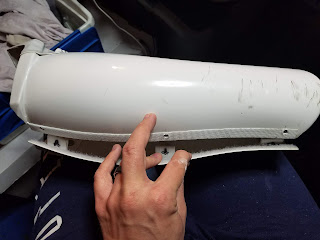Packing the Armor (FINALLY!)
My garrison mate TK-70701 came in, in a pinch, to keep me from wasting more money on bins that would still be too over-sized for the airline or having to relay on rendezvous-ing with a Kessel Run. It's the same suitcase he used to transport his armor abroad and back with little armor damage. Hopefully my luck as as good as his!
The trick was getting everything in there without bending or breaking anything. It took me a few attempts to get everything in there. but finally I had a revelation.
The trick is the thigh pieces, being the biggest rigid parts, and mine are shimmed to be bigger, making them larger than some. So the trick is to pack as much armor in them as possible, and fit everything else around them, like the ab/ kidney plates which are permanently attached on one side due to the left side strapping. Usually I don't take the shoulder bells off my arm pieces when I use the Huskys, but when I did, I was able to pack everything together tightly.
Here's how I played #TKTetris, keeping in mind that the case is already foam-lined:
- Put the boots on the bottom of the suitcase (they're heavy and should be on the top of the case when it's vertical).
- Stuff the hand guards into the forearms; forearms into the biceps; biceps into the shins; shins into the thighs (with some foam padding between the shins and inside of thighs for extra shock absorption and rigidity).
- Lay the ab/ kidney/ butt assembly into the luggage, kidney and butt plate down, but upside down (cod towards the top of the suitcase). This way the flat parts of those pieces face down when the case is vertical, reducing the chance of the cod piece cracking.
- Lay down some foam inside the kidney and butt plates.
- Lay the stuffed thighs into the inside of the assembly (alternating top to bottom for a better fit for both thighs) after laying down some foam.
- Undersuit and soft parts are stuffed in the bottom between the boots and armor for extra cushioning.
- Shoulder bells go to top of suitcase above thighs. (keep them from getting crushed when case is vertical).
- Lay more foam, and close the ab piece on top of the thighs.
- Lay more foam, rest the chest pieces & shoulder straps on top of and over the cod piece; rest the back piece below and underneath that.
- Lay more foam on top.
- Thermal Detonator and repainted Disney blaster get wrapped separately and gently squeezed into the hinge side of the suitcase (blaster is marked for easy TSA inspection as need be).
- Repair kit with new tube of CA glue gel, spare ABS scrap, Chicago Screws, safety pins, and other stuff gets slipped inside the armor near the shoulder bells.
- Place note inside suitcase for TSA (heavily borrowed from one written by TK-70701 when he traveled with his armor).
- Orange pauldron with SCG logo is wrapped in a clear plastic bag and goes on very top (to act as extra padding too).
- Close it up, put the TSA lock on it. Done!
This seems like the best setup for the job. The armor supports each other with quite a bit of foam padding to help with absorbing shock. I'll just have to pray that the gorilla baggage handlers aren't too rough with the case.
TK-70701's suitcase ended up being... very on-the-nose for this job. Not that I'm complaining. Quite the contrary.
When in Rome...
The Other Stuff
The TKTalkie and other electronics are traveling in my clothing suitcase. I could have probably put that stuff inside the armor somewhere (maybe), but I'd rather have TSA open the other bag than have to unpack my armor to get to anything, and then have them re-pack it incorrectly and risk damaging anything. The electronics are in a marked baggie ready for TSA to easily inspect them as need be.
Yes, I had to pack other clothes too I suppose, including my black staff officer outfit, t-shirts, pants, and my club shirt. Must remember an umbrella as well, thanks to Winter Storm Wesley :/
REPRESENT.
... I'll have to fix that one patch later. Tilted.
It's getting really close. Last night I made sure I had everything for my armor. Good thing too; I almost forgot to pack the web belt for the thigh garters. Tonight I make sure my clothing case is packed and nothing important is missing (especially the CON PASSES), as well as packing my carry-on that will travel in the plane wit my bucket and I.
I haven't been so nervous in... a while. I think I'll be better once I get to Illinois. I hope so. We'll see how the armor holds up in air travel. Until next time...








 My trip into making stormtrooper armor and ultimately joining the 501st Legion began at Celebration 2015 in Anaheim, California. It was after Celebration where my friend and coworker told me about the Anovos deal which got me and many others in on the ground level for a song.
My trip into making stormtrooper armor and ultimately joining the 501st Legion began at Celebration 2015 in Anaheim, California. It was after Celebration where my friend and coworker told me about the Anovos deal which got me and many others in on the ground level for a song.




























